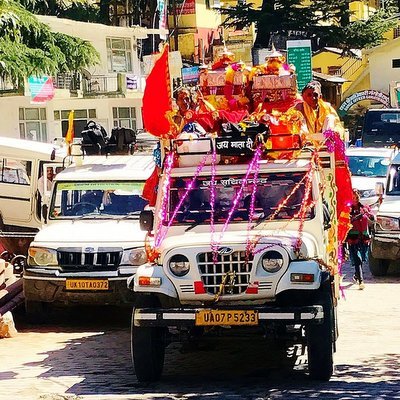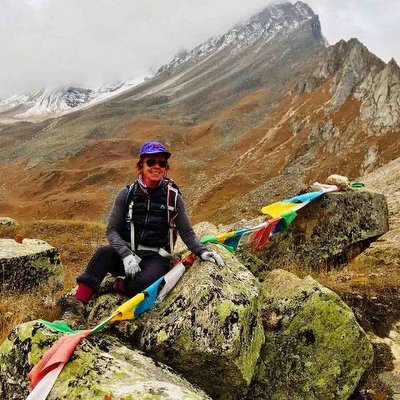Season 3 – Spring
As a child growing up in Australia, my favourite season was always Spring. Cool mornings, followed by days that were warm and then again as the sun set, cool evenings.
Stage 4 of the race was designed to cover real desert. A terrain made up of sweeping plains. And true enough this is exactly what the competitors were provided.
The start line was cool, with my day’s assignment being CP 1 again. CP1 was pretty much at the point where cold turned into something not so cold. After 10kms the competitors were treated to a very quick increase in temperature - ‘Spring-like conditions’, making their way across a truly desert like landscape. The check point was adjacent to a watering hole which allowed us to watch some semi wild horses coming past, only giving us a cursory look as they clearly thought we were crazy being out here in the middle of nowhere.
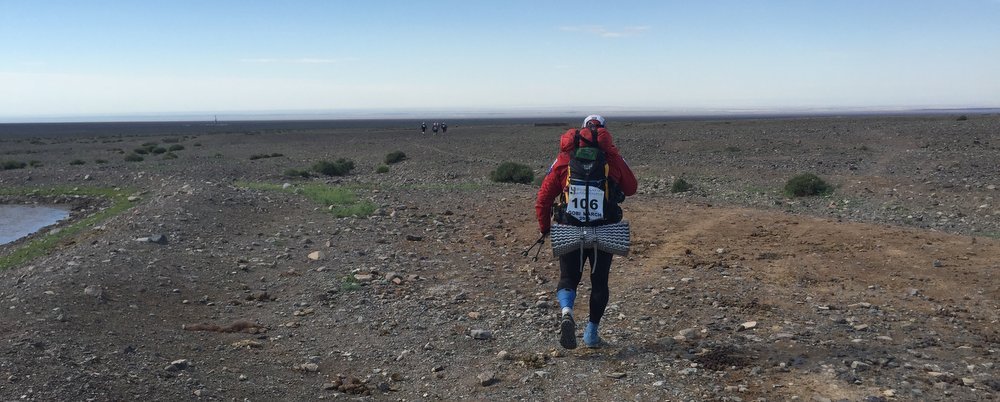
Competitors started filtering through from mid morning and all looked fit and well and much happier given the increase in temperature. Outer layers came off at the check point as comments flew about cursing the cold conditions that were finally being left behind.
For a little background, some of the volunteers were assigned a duty called ‘sweeping’. As a sweeper your task is to basically follow the last competitor/s and collect up the course markers. Sweeping although not overly taxing is still a difficult role and for most volunteers, many of whom are accomplished athletes in their own right, can be quite boring and frustrating as you are fixed to walk the course at the slowest pace of the last competitor.
To alleviate what some might call boredom, sweepers do have the opportunity to take in the amazing scenery along the course as they stroll along the 40 odd kms per day. The Gobi March adds a little extra distraction to the role of sweeping. For the whole race we had a mascot accompanying the sweepers, our very own camel (and he had also bought his friend along, a horse).
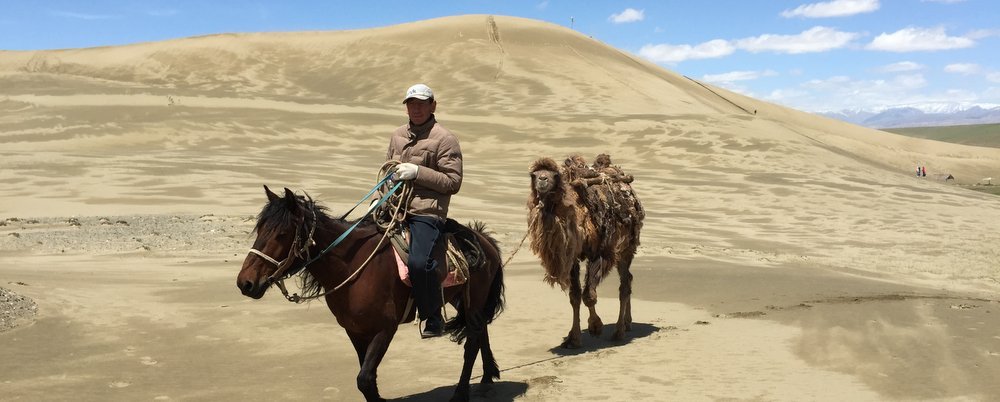
The camel, as the story goes, was originally used to potentially assist any needy competitor in case they had to withdraw. However over the number of years this really didn’t need to happen and now the camel acts as the unofficial mascot and signals the end of the race as it comes through the finish line at each stage.
On stage 4 we did have a little logistical issue with our mascot. The course had been marked to go through a tunnel (actually a water run-off, that went under a highway in the middle of the desert, through which competitors basically crawled. Apparently there was not much consideration for the fact that camels are unable to do the same. Now the tunnel only being 4ft high and the camel easily being 6ft high our friendly 4 legged friend decided to show its disapproval for the lack of consideration and stopped dead in defiance.
Unbeknown to most, as the sweepers came in that evening without the camel, comments throughout the camp started with worry about the camel and why it had not made to camp with the sweepers as per normal.
Were there competitors missing? Was there something wrong with the camel?
Turns out it had to make a 2 hour detour. A general revelation to most is that camels can be stubborn and this one in particular had to make its own decision at which point it would cross the highway above ground.
Camp for that night was finally warm and pleasant, placed within some old and now uninhabited workers cottages. The day for me was mixed. Happy the cold was gone yet unfortunately JP, the real hero here and the one that had prompted my volunteering & attendance, had to withdraw. He was, in the end, ok but admirable that he had made the correct decision at the time, as personal safety and health is the number one consideration throughout the event.
Season 4 – Summer
The next Stage is ‘The Long March’. Here the stage takes competitors across 80kms of open desert, this was in the brochure, unlike the snow conditions earlier in the week.
There is a CP approximately every 10 kms (give or take). My assignment, with a couple of others, was CP5, 50kms in and the check point where competitors are permitted to rest, have a meal and prepare for the remaining 30km trek to the stage finish line.
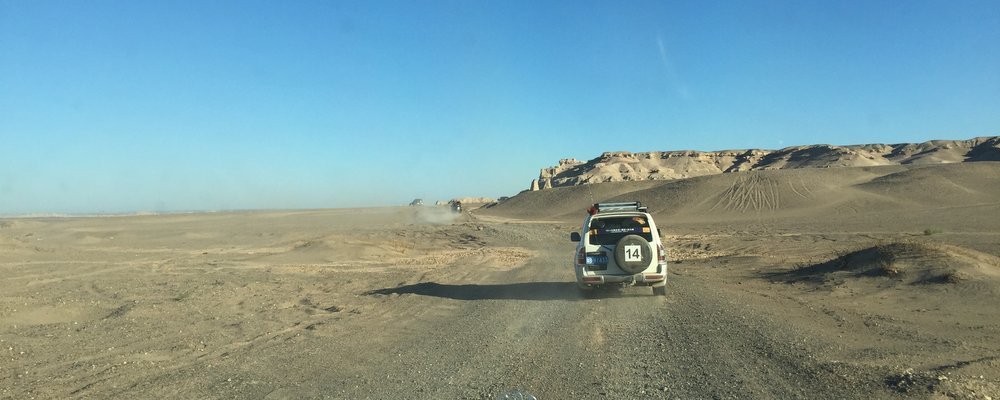
Competitors commence the long march at 8am and have until midday the next day to complete. Roughly 30 hours to complete 80km.
The front runners make it to the camp (finish for that stage) by late afternoon on the first day. The more normal competitors take a relaxed pace and are able to undertake much of the section in the dark.
Here we find some dilemmas to deal with. As a front runner, you are subjected to the full heat of the day for the whole distance. The idea is to finish as quickly as possible. Though you may finish earlier, you do run most of the day in temperatures of between 35 and 45 degrees Celsius. Tough in anyone’s book.
At a more relaxed pace, other competitors are able to do roughly 50% in cool dusk and evening temperatures which were a very pleasant 25-28 degrees. The dilemma: To run or not to run?

CP5 for me was by far the most enjoyable assignment as a volunteer. 3 of us, 2 volunteers and 1 doctor were dropped out in the middle of the desert to set up the CP and await the competitors.
At the 50km mark the first competitors were not due until around midday. We had the CP set up by 8am which allowed us a little exploring time, or in my case a little extra sleep after the now daily 4:30am start. Also as the field is well stretched out at this distance there is very little by way of rush hour so a nice steady stream of competitors made for a relaxed waypoint and we were able to get to know many of the competitors as they stopped for some food and to regain a little energy before setting out again.
All competitors had to be out by 2:00am, and with an hour to go and only a small number taking their time, the CP team ended up having quite a pleasant ‘camp fire’ get together and then a very much appreciated sleep under the stars once all the competitors had left. I did feel a little sorry for the sweepers that day though … at least until I fell asleep.
Season 5 – Plague Of Locusts
Well not really. But we did get treated to some interesting climate changes deserved of its own additional season.
Packing up our check point from the previous day, our small team made its way to the finish line for the Long March stage. The site was located in a beautiful area surrounded by sandstone outcrops, with the finish line set up between two of these.
The morning started out warm, as one would expect, with the last competitors crossing with the sweepers late morning. The rest of the day was to be a much needed down time for all involved. Or so we thought.
As the day progressed the wind started to gradually increase. Annoying as it was, it wasn’t too bad initially. Unfortunately it continued to gain strength to a point where tents were being blown over with staff and competitors alike starting to seek shelter in and around the rocks. This deterioration in weather persisted to a point where decision to pull down tents was made.
As we started someone pointed into the distance exclaiming “WTF is that?” Here many saw their first sandstorm front approaching. An ominous sight. A huge cloud of dust and sand making its way across and over the terrain, straight towards the campsite.
With some quick decisions, all who were capable began to secure as much as possible around the campsite. Having been in a sandstorm once before, the greatest issue is not the storm itself but loose camp items that may get picked up by the storm and bulleted about. The fear of collateral damage by wayward rubbish or a tent that makes its way loose is the danger.
With the camp as secure as possible we waited for the storm to hit, and hit it did with a great deal of force. The sight of 200 people huddled together was a little eerie. The sandstorm felt relentless and continued for almost 2 hours, even the locals were a little disturbed, suggesting at one point it may last well into the night.
Generally everyone handled the challenge well, although some seemed unable to appreciate the potential risk, happily wandering around oblivious to the threats posed by flying objects. Thankfully there were no injuries.
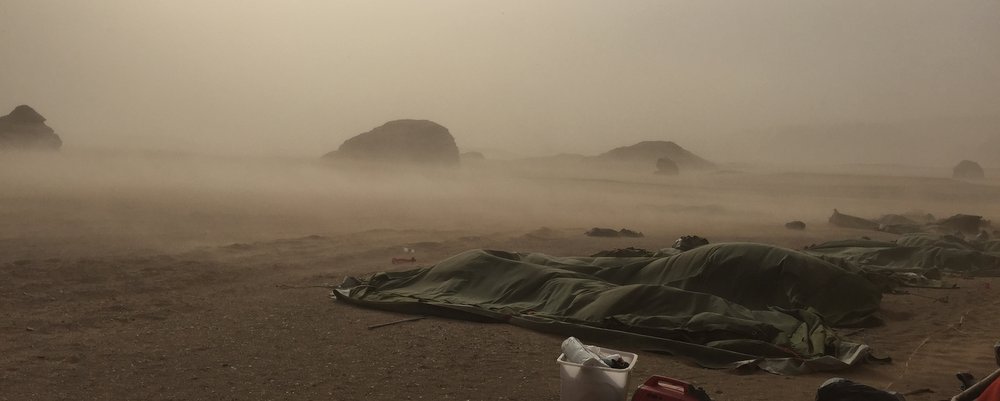
One not so commonly known fact is the high potential of rain that can follow a sandstorm. With deserts not known to absorb water so well, flash flooding was now an additional risk. A discussion which was clearly being had by those in charge.
After some time it was decided the risk was low, with the sandstorm subsiding. The camp site was sadly looking a little worse for wear. A sleep out with all competitors and staff finding a spot to crawl into sleeping bags under the stars to get some much need sleep was in order but not until around 11pm.
The calm unfortunately didn’t last too long.
Around 3am the rain started, heavy enough for the more experienced in the party to raise concern. With the risks to competitors too high the appropriate decision was made to evacuate and cancel the last stage, the 11.8 km final run to the finish.
This decision was almost unanimously met with approval. Most not having had less than 4 hours sleep, with very little prepared for the next day and a constant drizzle of rain making everyone miserable.
We all boarded the emergency transport for the trip back to Hami. An unusual quiet came across the buses, confirming everyone was done. The Gobi weather had finally won out against the intrepid competitors. All of who were weary, just wanting to have a shower, a real meal, a sleep in a real bed and, for many, a much deserved beer so they could start sharing the stories of the Gobi March 2015 – where we literally had Four Seasons In One Week and the Gobi reminded us all it still remains the windiest desert on the planet and we could add with the most diverse weather conditions.




